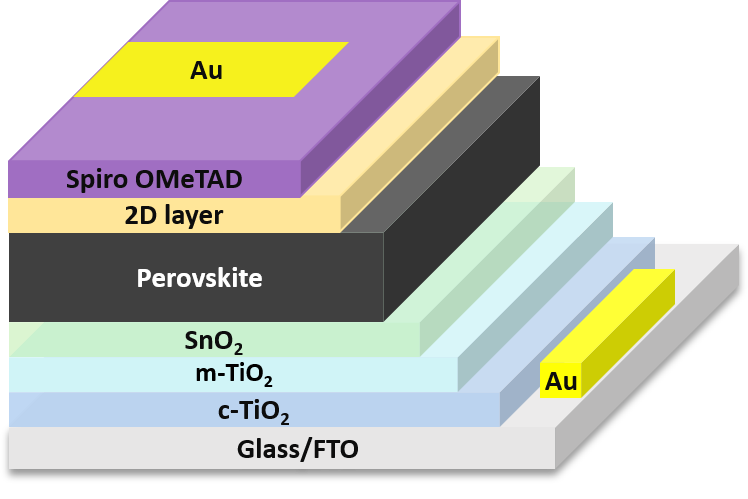An international research team created a 3D/2D perovskite solar cell using a triple-cation perovskite absorber treated with phenethylammonium iodide (PEAI), a modulator that alters the perovskite film's surface energy and forms a quasi-2D structure without further annealing.
“We are currently planning to set up an experimental production line in Turkey,” researcher Gorkem Gunbas told pv magazine. “It could be operational in 2025.”
Perovskite cells built with 2D hybrid materials are known for their stability and exhibit large exciton binding energy compared to conventional, 3D devices. Different organic ammonium salts have been tested to develop 3D/2D solar cells, with halogenated analogs of PEAI salts being the preferred choice due to their potential to enhance hole extraction.
For their 3D/2D solar cell, the team used three organic ammonium salts: 2-methoxy-PEAI (o-OMe-PEAI), 3-methoxy-PEAI (m-OMe-PEAI), and 4-methoxy-PEAI (p-OMe-PEAI). They built the device with a fluorine-doped tin oxide (FTO) substrate, a commercially pure titanium oxide (cp-TiO2) electron transport layer, a mesoporous titanium dioxide (mp-TiO2) layer, a tin(IV) oxide (SnO2) buffer layer, the perovskite layer, the OMe-PEAI layer, a spiro-OMeTAD hole transport layer, and a gold (Au) metal contact.
“A solution of methoxy-substituted salts in isopropanol (IPA) was coated on it by spin coating to form the 3D/2D perovskite structure,” they explained. “Perovskite films treated with methoxy-substituent salts have fewer bright grains on the surface, indicating that OMe-PEAI salts react with excess lead(II) iodide (PbI2) on the 3D perovskite surface.”
The resulting solar cell achieved a power conversion efficiency of 23.08%, an open-circuit voltage of 1.120 V, a short-circuit current of 25.55 mA/cm2, and a fill factor of 80.6%. A reference cell without the PEAI treatment reached an efficiency of 20.86%, an open-circuit voltage of 1.091 V, a short-circuit current of 24.55 mA/cm2, and a fill factor of 78.0%.
Popular content
“All 3D/2D PSCs treated with methoxy-substituted salts showed lower hysteresis than the reference solar cell, indicating suppressed ion migration and accumulation by passivating the defects on the perovskite surface,” the researchers stated, noting that the champion device retained 95% of its initial efficiency after 900 hours, while the reference cell maintained only 49%.
“The unique orientation of the o-OMe-PEAI on the 3D perovskite surface revealed higher hydrophobicity compared with other salts, which in turn reflected the higher stability of the resulting devices,” they added.
The team introduced the cell technology in the paper “Drastic influence of substituent position on orientation of 2D layers enables efficient and stable 3D/2D perovskite solar cells,” which was recently published in Cell Reports Physical Science.
The team includes scientists from the École Polytechnique Fédérale de Lausanne (EPFL) in Switzerland, Odtu-Gunam and the Middle East Technical University (METU) in Turkey, the Lomonosov Moscow State University in Russia, and the University of Tokyo in Japan.
This content is protected by copyright and may not be reused. If you want to cooperate with us and would like to reuse some of our content, please contact: editors@pv-magazine.com.



By submitting this form you agree to pv magazine using your data for the purposes of publishing your comment.
Your personal data will only be disclosed or otherwise transmitted to third parties for the purposes of spam filtering or if this is necessary for technical maintenance of the website. Any other transfer to third parties will not take place unless this is justified on the basis of applicable data protection regulations or if pv magazine is legally obliged to do so.
You may revoke this consent at any time with effect for the future, in which case your personal data will be deleted immediately. Otherwise, your data will be deleted if pv magazine has processed your request or the purpose of data storage is fulfilled.
Further information on data privacy can be found in our Data Protection Policy.